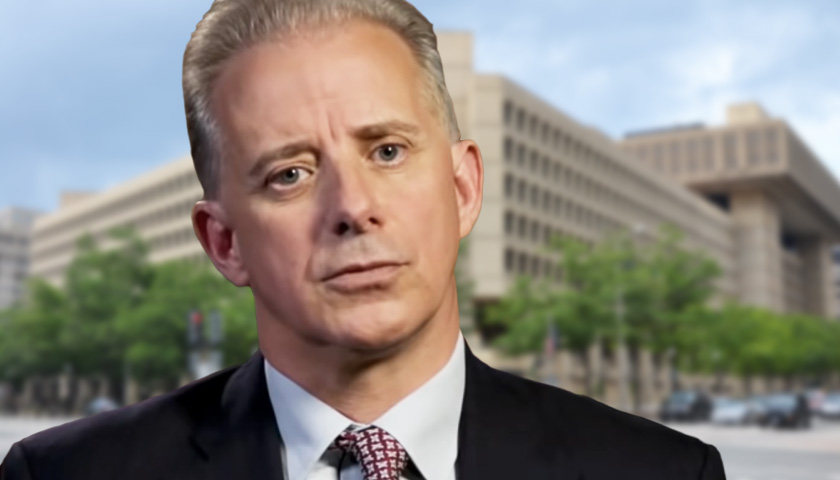by Paul Sperry
The FBI relied more extensively on Christopher Steele’s debunked dossier in their Russiagate investigation than has been revealed, inserting key parts from it into their applications for warrants to spy on the 2016 Trump campaign.
Agents did this without telling the Foreign Intelligence Surveillance Court that the precise wording was plucked directly from a political rumor sheet paid for by Hillary Clinton’s campaign or providing judges with any independent corroboration of the explosive allegations.
But the notion that mere “snippets” of the reporting by paid Clinton subcontractor Christopher Steele showed up in FISA applications, as CNN has described it, no longer holds up to scrutiny.
A close examination of all four of the FISA warrants reveals that the FBI lifted dozens of key phrases – as well as practically some entire sentences – from the dossier and pasted them verbatim into their sworn affidavits. It did so repeatedly without citing its sources or using typical hedging language such as “allegedly” or “purportedly” to indicate that the claims were unverified.
As a result, the FBI lent its voice of authority to many of the unsourced – and now debunked – accusations in the dossier.
For example, bureau lawyers avowed under oath in all four warrant applications that “the FBI has learned” that onetime Trump campaign adviser Carter Page had secretly met with sanctioned Kremlin officials in Moscow. But those allegations came from Steele’s D.C.-based collector Igor Danchenko, who admitted to the FBI in a January 2017 interview his input was just “hearsay” gathered from “conversation with friends over beer.”
It is not clear whether the bureau decided to pay Steele in connection with the dossier so that it could represent the material as originating from one of its own confidential sources. At one point it reportedly offered him $1 million if he could verify key claims (he could not).
Meanwhile, the FBI repeatedly portrayed improbable third-hand rumors as sound “intelligence,” despite taking them directly from paid political opposition research operatives. Suggesting independent verification, the bureau repeatedly assured the FISA court it “assesses” the truth of damning claims.
In some cases, the FBI mixed partial information from one dossier report with partial information from another report to draw broader conclusions. It then used these as a foundation to claim evidence of a grand election “conspiracy” between the Trump campaign and Russia, with Page acting as an “intermediary.” Such a conspiracy was what counterintelligence agents needed to convince the FISA court that their main target Page was a Kremlin agent who posed a national security threat, and that deploying the government’s most intrusive investigative method – electronic surveillance – was necessary to investigate him.
In short, the FBI fabricated conclusions from fabrications and turned them into sworn representations before the powerful Foreign Intelligence Surveillance Court.
Veteran FBI investigators who have worked counterintelligence cases and sworn out wiretap warrants say the agents who ran the Russiagate investigation, codenamed Crossfire Hurricane, violated the fundamental principle requiring them to independently verify evidence they present to the court.
“Their actions – lying and misrepresentations on warrants and affidavits – are antithetical to every instruction at FBI training at Quantico and in the field,”said 27-year FBI veteran Michael Biasello. “Any FBI Academy trainee and agent in the field is aware that search warrants, affidavits and any accompanying documents and information contained therein requiring federal judicial approval is to be vetted and verified to create a pristine document. Their accuracy is vital.”
The FBI declined comment.
The bureau’s reliance on the dossier – a series of 17 reports compiled by Steele for Fusion GPS, the Washington-based opposition research firm employed the Clinton campaign and the Democratic National Committee – has been brought into sharp relief by the work of Special Counsel John Durham.
His team investigated for possible criminal misconduct the Russiagate probe that hobbled the Trump presidency. It zeroed in on the FBI’s handling of the dossier both before and after theagency began using it to gain FISA court approval to wiretap Page in 2016 and 2017. Investigators questioned several FBI witnesses about their interactions with Steele and Danchenko, some of whom Durham said were not forthcoming about their involvement, and obtained related documents. Danchenko, who provided an estimated 80% of the dossier’s content, was indicted last year for lying about the sources of his information, though he was acquitted in October by a D.C.-area jury.
Like CNN, the New York Times has tried to minimize the agency’s reliance on the dossier. In a recent article on Durham’s inquiry, the Times maintained that the FBI only used “some” claims from the dossier in applying for court permission to wiretap Page.
In fact, the FBI used several claims – and those claims happened to constitute the most critical “evidence” in the wiretap applications. Even former deputy FBI director Andrew McCabe has admitted that if not for the Steele dossier, no surveillance warrant would have been sought for Page.
All told, the FBI used four dossier reports – Report 80, Report 94, Report 95 and Report 102 – in all four of its FISA wiretap warrants targeting Page in 2016 and 2017. And three of the reports were based on a fictitious source.
A side-by-side comparison of the texts of the FBI’s original Oct. 21, 2016, warrant affidavit and the dossier reports reveals several areas of significant overlap, similarities that have not been previously reported. The FBI effectively plagiarized Steele, the London-based author of the reports, lifting whole phrases and sentences without bracketing off his words in quotation marks.
For instance, Steele wrote the following in Report 102, based on a conversation Danchenko falsely claimed to have had with a Trump “associate” (document images here):
TRUMP’s associate reported that the aim of leaking the DNC e-mails to WikiLeaks during the Democratic Convention had been to swing supporters of Bernie SANDERS away from Hillary CLINTON and across to TRUMP. … This objective had been conceived and promoted, inter alia, by TRUMP’s foreign policy adviser Carter PAGE who had discussed it directly with the ethnic Russian associate.
For comparison, here is what the FBI stated in all of its wiretap applications, using virtually the same language, except referring to the Russia-born Trump associate as “Sub-Source E”:
Sub-Source E reported that the above-described leak of the DNC e-mails to WikiLeaks had been done, at least in part, as an attempt to swing supporters of an identified individual who had been running against [Clinton] for their political party’s nomination, away from [Clinton] and to [Trump]. Sub-Source E reported that this objective had been conceived and promoted by, among other things, Page, who had discussed the objective directly with Sub-Source E.”
Sub-Source E was later revealed to be an American real estate man and Trump booster named Sergei Millian. Despite the implication, Millian was not an FBI source. Instead, he allegedly provided a stream of bombshell claims to Danchenko, who then fed them to Steele.
But Danchenko never actually spoke with Millian, as Durham’s investigators discovered from phone and email records and other evidence. Danchenko invented his source, which means he also made up the allegation that Page masterminded the DNC email leak, a claim the FBI vouchsafed to the FISA court to attain the Page wiretap.
Now turn to Steele Report 95, which was based on the same fictitious source.
The claim that the Trump campaign colluded with Russia to steal the 2016 election hangs on the “conspiracy of cooperation” allegation put forth in thisreport. It is the linchpin to Russiagate. Pull it and the whole case falls apart. Until the FBI in the summer of 2016 received Report 95 and its explosive claim of a “well-developed conspiracy of co-operation” between the Trump campaign and Russian government, it struggled to establish probable cause to spy on Page. Report 95 is what pushed its application over the line. Here’s what Steele wrote (document images here)
Speaking in confidence to a compatriot in late July 2016, Source E, an ethnic Russian close associate of Republican US presidential candidate Donald Trump, admitted that there was a well-developed conspiracy ofco-operation between them and the Russian leadership. This was managed on the TRUMP side by the Republican candidate’s campaign manager, Paul MANAFORT, who was using foreign policy advisor, CarterPAGE, and others as intermediaries. … Inter alia, Source E, acknowledged that the Russian regime had been behind the recent leak of embarrassing e-mail messages, emanating from the Democratic National Committee (DNC), to the WikiLeaks platform. The reason for using WikiLeaks was “plausible deniability” and the operation had been conducted with the full knowledge and support of TRUMP and senior members of his campaign team.In return the TRUMP team had agreed to sideline Russian intervention in Ukraine as a campaign issue and toraise US/NATO defence [sic] commitments in the Baltics and Eastern Europe to deflect attention away fromUkraine, a priority for PUTIN who needed to cauterise the subject.
With this key dossier report in hand, the FBI, in turn, fatuously repeated the allegations, changing words hereand there, but writing virtually the same thing in its warrant applications, while attributing the accusations directly (and falsely) to Millian instead of the dossier. The relevant text is found on page 20 of the affidavit, forcomparison:
According to information provided by Sub-Source E [redacted section describing Millian], there was ‘a well-developed conspiracy of co-operation between them [assessed to be individuals involved in Candidate #1’s (Trump’s) campaign] and the Russian leadership.’ Sub-Source E reported that the conspiracy was being managed by [Trump’s] then campaign manager, who was using, among others, foreign policy advisor Carter Page as an intermediary. Sub-Source E further reported that that the Russian regime had been behind the .. disclosure of DNC e-mail messages to WikiLeaks. Sub-Source E reported that WikiLeaks was used to create ‘plausible deniability,’ and that the operation had been conducted with the full knowledge and support of [Trump’s] team, which the FBI assesses includes at least Page. In return, according to Sub-SourceE, [Trump’s] team, which the FBI assesses includes at least Page, agreed to sideline Russian intervention in Ukraine as a campaign issue and to raise U.S./NATO defense commitments in the Baltics and Eastern Europe to deflect attention away from Ukraine.
In its copy-and-paste, the FBI made sure to change Steele’s spelling of the word defense from the British style –“defence” – to the American style.
In Report 95, Steele also claimed that the hack-and-dump conspiracy was run out of the Russian consulate inMiami. Except it doesn’t exist. Moscow maintains no such diplomatic branch in Miami. This was a clear red flag regarding the reliability of Steele’s information. But the FBI still used it as no less than the cornerstone of its probable cause.
On page 10 of the FISA warrant application, the FBI reiterated that Page “has been identified by sourcereporting as an intermediary with Russian leadership in a ‘well-developed conspiracy of co-operation’ toinfluence the 2016 U.S. presidential election.”
Again, the agency made no reference to the Clinton-commissioned dossier – just to “source reporting,” whichwas nothing more than Danchenko’s imagination. His invented source Millian never provided any of the information for Report 95 – or for the rest of the dossier.
In its wiretap request, the FBI even cribbed from the dossier’s infamous pee-tape memo – Report 80 – whichwas also attributed to the fake source (Millian).
In addition to falsely claiming that Moscow held a blackmail sex video of Trumpcavorting with urinating hookers at the Ritz-Carlton, Moscow, Report 80 alleged that the Kremlin had “kompromat” on Hillary Clinton and was feeding it to Trump – and that it had been “very helpful” to his campaign. The compromising information on Clinton, which the report ironically referred to as a “dossier,” was said to be “controlled exclusively by chief Kremlin spokesman Dmitriy Peskov, who was responsible forcompiling/handling it on the explicit instructions of [Russian President] PUTIN himself.”
The FBI found this to be valuable “intelligence” and included it in all its FISA applications. Adopting the same language of Report 80 (document images here), it told the FISA court that “this dossier [on Clinton] was, by the direct instructions of Russian President Putin, controlled exclusively by Senior Kremlin Spokesman Dmitriy Peskov.” It added, further parroting Report 80, that the information had been “very helpful” to Trump.
Then the FBI went one step further than anything Steele reported. “Accordingly,” the bureau’s FISA application said on page 19, “the FBI assesses that [Kremlin official Igor] Divyekin received direction by the Russian Government to disclose the nature and existence of the dossier [on Clinton] to Page.”
Divyekin is not named in Report 80. It appears instead that the FBI got his name from another Steele memo, Report 94, and then injected him into the narrative. Report 94 was also a treasure trove of misinformation. It claimed that the Kremlin spokesman had held “secret meetings” with Page, along with U.S.-sanctioned Russian official Igor Sechin, during a trip Page made to Moscow in July 2016.
The bureau then made this reporting its own in a FISA application, telling the court, “The FBI has learned that Page met with at least two Russian officials during this trip,” even though it had no independent knowledge of such a meeting. While Page did travel to Moscow at the time to give a speech at a college where President Obama also once spoke, the secret meetings were another tall tale. Page told agents he didn’t even know who Divyekin was. But that didn’t stop the FBI from inserting the false rumors into its spy warrants (document images here).
Report 94 claimed that during the alleged meetings, Page and Sechin raised “issues of future bilateral US-Russia energy co-operation and associated lifting of western sanctions against Russia over Ukraine.” The FBI repeated the allegation on page 17 of its original warrant affidavit using the same wording with no attribution to the dossier: “Page and Sechin discussed future bilateral energy cooperation and the prospects for an associated move to lift Ukraine-related Western sanctions against Russia.” Report 94 claimed that “Page had reacted positively” to the talks, and the FBI regurgitated the same line in its application that “Page had reacted positively to the discussions.”
Also, the report claimed that Divyekin and Page talked about releasing the alleged anti-Clinton “kompromat” to the Trump campaign. This was a convenient piece of “evidence” for the FBI, which was looking to tie inreporting it received separately from an Australian diplomat that another Trump campaign adviser, GeorgePapadopoulos, had “received some kind of suggestion from Russia that Russia could assist with the anonymous release of information during the campaign that would be damaging to [Clinton],” according to page 9 of the FISA application.
Though it noted this overseas tip was “unclear,” the application said the “FBI believes that election influence efforts are being coordinated between the RIS [Russian Intelligence Service] and Page, and possibly others.”
This appears to be why the FBI drew the conclusion that Divyekin had “received direction by the Russian Government” toshare the Clinton dirt with Page, a stretch even for the dossier, which never said Divyekin was operating on orders from the Russian government. But the FBI needed Russian intelligence to be involved to sell the espionage “conspiracy.”
The imagination of Crossfire Hurricane agents was running full throttle, but then they made an even bigger leap. At the top of page 20 of their first FISA request, they stated: “The FB assesses the information funneled by the Russians to Page may be part of Russia’s intent to influence the 2016 U.S. Presidential election.”
This put a nice bow on the grand conspiracy for the FISA court, which is that Russia helped Trump steal theelection.
The way the FBI framed it for FISA judges, it was an urgent matter of national security to let agents monitor Page –and also collect any past communications he had with Trump campaign officials – to stop the theft of the White House by the Kremlin.
‘Heads Should Roll’
As the Crossfire case bled into the inquiry directed by Special Counsel Robert S. Mueller, it became more and more obvious the FBI had given its imprimatur to a wide range of false allegations in its FISA applications.
By autumn 2017, investigators understood full well that the dossier allegations were fabricated by Danchenko. The FBI finally let the Trump-relatedwiretaps expire in late September that year. To this day, Page has never been charged with a crime.
In each of their four sworn FISA affidavits, which were signed by then-FBI Director James Comey and his deputy McCabe, FBI agents told the FISA court that Danchenko was “truthful and cooperative,” when they knew otherwise. Instead of going back to the court and correcting the record, as required by law (whichrisked acknowledging the fraud) they fished for more dirt, more unsubstantiated rumors about Trump, from the same unscrupulous sources. They continued to meet with Steele and Danchenko throughout 2017.
Former FBI investigators say it’s clear their colleagues weren’t played by their sources, but rather played along with them.
“The bureau was not misled. The bureau received false information,knew it to be false, and still represented it as true for the purpose of the affidavits,” Biasello said. “That is a blatant criminal act.”
He noted that in a December 2019 opinion, then-FISA Court Presiding Judge Rosemary Collyer reprimanded the FBI, while warning that other FISA warrants may be equally tainted and based on fraudulent information.
“The frequency with which representations made by FBI personnel turned out to be unsupported or contradicted by information in their possession,and [the frequency] with which they withheld informationdetrimental to their case, calls into question whether information contained in other FBI applications is reliable,” wrote Collyer, who signed the initial warrant targeting Page.
“In view of her comments, heads should roll,” Biasello said.
– – –
Paul Sperry is an investigative reporter for RealClearInvestigations. He is also a longtime media fellow at Stanford’s Hoover Institution. Sperry was previously the Washington bureau chief for Investor’s Business Daily, and his work has appeared in the New York Post, Wall Street Journal, New York Times, and Houston Chronicle, among other major publications.
Photo “Christopher Steele” by Good Morning America. Background Photo “FBI Headquarters” by Sammy Six. CC BY 2.0.








